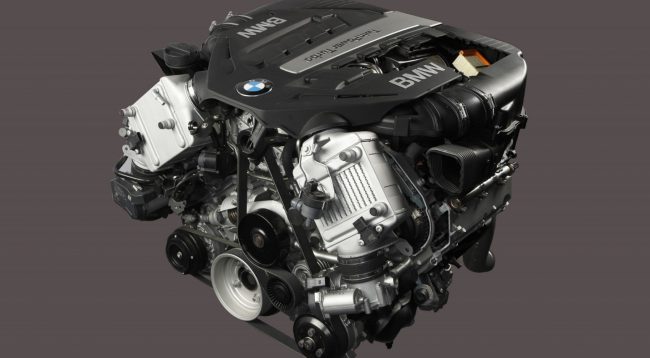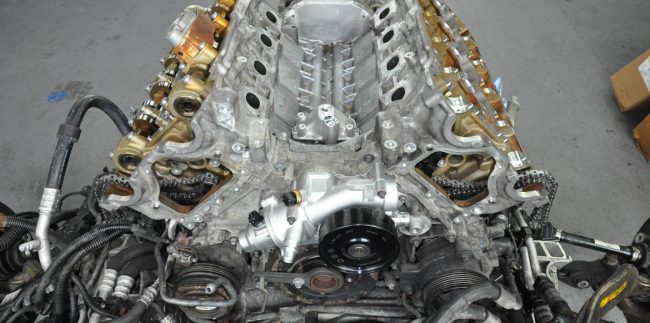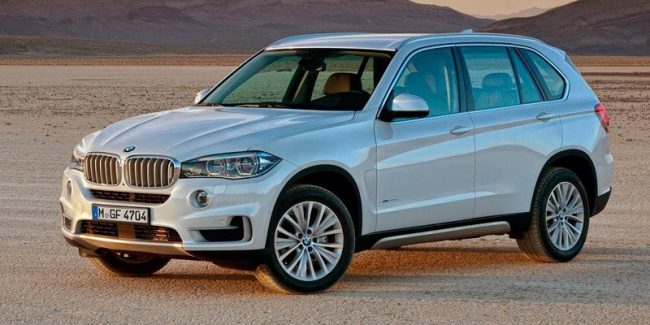
BMW N63B44, N63B44TU engines
Content
BMW connoisseurs are familiar with the N63B44 and N63B44TU engines.
These power units belong to a new generation, which fully complies with the current Euro 5 environmental standard.
This motor also attracts drivers with high-quality dynamics and speed characteristics. Let's look at them in more detail.
Engine Overview
The release of the basic version of the N63B44 began in 2008. Since 2012, the N63B44TU has also been modified. Production was established at the Munich Plant.
 The motor was intended to replace the obsolete aspirated N62B48. In general, the development was carried out on the basis of its predecessor, but thanks to the engineers, very few nodes remained from it.
The motor was intended to replace the obsolete aspirated N62B48. In general, the development was carried out on the basis of its predecessor, but thanks to the engineers, very few nodes remained from it.
The cylinder heads have been completely redesigned. They received a different placement of intake as well as exhaust valves. At the same time, the diameter of the exhaust valves became equal to 29 mm, and for the intake valves it is 33,2 mm. The cylinder head system has also been improved. In particular, all camshafts received a new phase in 231/231, and the lift was 8.8/8.8 mm. Another bushing toothed chain was also used to drive.
A completely custom cylinder block was also created, aluminum was used for it. A modified crank mechanism was installed in it.
The Siemens MSD85 ECU is used for control. There is a pair of Garrett MGT22S turbochargers, they work in parallel, providing a maximum boost pressure of 0,8 bar.
In 2012, a modified version, N63B44TU, was launched into the series. The motor received upgraded pistons and connecting rods. The range of adjustment of the gas distribution mechanism has also been expanded. A new engine control unit was used - Bosch MEVD17.2.8
Technical specifications
Motors have excellent dynamics, which is due to technical characteristics. For ease of comparison, all the main indicators are summarized in the table.
| N63B44 | N63B44TU | |
|---|---|---|
| Engine displacement, cc | 4395 | 4395 |
| Maximum power, hp | 450 (46) to 4500 600 (61) to 4500 650 (66) to 1800 650 (66) to 2000 650 (66) to 4500 650 (66) to 4750 700 (71) to 4500 | 650 (66) to 4500 |
| Maximum torque, N * m (kg * m) at rpm. | 400 (294) to 6400 407 (299) to 6400 445 (327) to 6000 449 (330) to 5500 450 (331) to 5500 450 (331) to 6000 450 (331) to 6400 462 (340) to 6000 | 449 (330) to 5500 450 (331) to 6000 |
| Maximum power, h.p. (kW) at rpm | 400 – 462 | 449 – 450 |
| Fuel used | Gasoline AI-92 Gasoline AI-95 Gasoline AI-98 | Gasoline AI-95 |
| Fuel consumption, l / 100 km | 8.9 – 13.8 | 8.6 – 9.4 |
| engine's type | V-shaped, 8-cylinder | V-shaped, 8-cylinder |
| Add. engine information | direct fuel injection | direct fuel injection |
| CO2 emission in g / km | 208 – 292 | 189 – 197 |
| Cylinder diameter, mm | 88.3 – 89 | 89 |
| Number of valves per cylinder | 4 | 4 |
| Supercharger | Twin turbocharging | Turbine |
| Start-stop system | optional | Yes |
| The piston stroke, mm | 88.3 – 89 | 88.3 |
| Compression ratio | 10.5 | 10.5 |
| Out of resource. km. | 400+ | 400+ |
Owners of cars with such engines are very lucky that now they do not check the numbers of power units when registering. The number is located at the bottom of the cylinder block.
In order to see it, you need to remove the engine protection, then you can see the marking embossed with a laser. Although there are no inspection requirements, it is still recommended to keep the room clean.
Reliability and weaknesses
German-made engines have always been considered reliable. But, it is this line that is distinguished by the exactingness of maintenance. Any deviations can lead to the need for complex repairs.
All engines eat up oil well, this is primarily due to the tendency to coke the grooves. The manufacturer generally indicates that lubricant consumption up to a liter per 1000 kilometers is within the normal range.
Misfires may occur. The reason is the spark plugs. Often, mechanics recommend using spark plugs from M-series engines. They are completely identical.
Water hammer may occur. This happens after long downtime on the engines of early releases. The reason is in the piezo nozzles, in later assemblies other nozzles were used, devoid of this problem. Just in case, it is worth installing them without waiting for the occurrence of water hammer.
Maintainability
For many drivers, self-repair of BMW N63B44 and N63B44TU engines turns out to be an almost impossible task. There are several reasons for this.
Many units are mounted on bolts for specially shaped heads. They are not included in standard auto repair kits. You need to purchase them separately.
For most of the work, even minor ones, it is necessary to dismantle a large number of plastic parts. At official BMW services, the standard for preparing the engine for removal is 10 hours. In a garage, this work takes 30-40 hours. But, in general, if everything is done according to the instructions, there will be no problems.
Also, sometimes there may be difficulties with components. They are usually brought to order. This can complicate and delay the repair process somewhat.
What oil to use
As mentioned above, these internal combustion engines are quite demanding on the quality of the lubricant. Therefore, be sure to buy only synthetic oils recommended by the manufacturer. The use of engine oils with the following characteristics is considered optimal:
- 5W-30;
- 5W-40.
Please note that the packaging must necessarily indicate that the product is recommended and approved for use on turbocharged engines.
Oil should be changed every 7-10 thousand kilometers. Timely replacement significantly extends the life of the motor. It is recommended to immediately purchase a lubricant with a margin. 8,5 liters are placed in the engine, taking into account the consumption, it is better to take 15 liters at once.
Tuning Features
The most effective way to increase power is chip tuning. Using other firmware allows you to get an increase of 30 hp. This is very good considering the initial power. Moreover, the overall resource of the engine increases, after flashing it quietly serves about 500-550 thousand kilometers.
Cylinder boring is not effective, it only reduces the life of the block. If you want to change the design, it is better to install a sports exhaust manifold, as well as a modified intercooler. Such a refinement can give an increase of up to 20 hp.
SWAP capability
At the moment, there are no more powerful engines suitable for replacement in the BMW lineup. This somewhat limits the possibilities of motorists who prefer to replace the motor in order to improve technical characteristics.
What cars was it installed on?
Motors of these modifications were encountered quite often and on many models. We will list only those that can be found in Russia.
The N63B44 power unit was installed on the BMW 5-Series:
- 2016 - present, seventh generation, sedan, G30;
- 2013 - 02.2017, restyled version, sixth generation, sedan, F10;
- 2009 - 08.2013, sixth generation, sedan, F10.
It can also be found on the BMW 5-Series Gran Turismo:
- 2013 - 12.2016, restyling, sixth generation, hatchback, F07;
- 2009 - 08.2013, sixth generation, hatchback, F07.
The engine was also installed on the BMW 6-Series:
- 2015 - 05.2018, restyling, third generation, open body, F12;
- 2015 - 05.2018, restyling, third generation, coupe, F13;
- 2011 - 02.2015, third generation, open body, F12;
- 2011 - 02.2015, third generation, coupe, F13.
Limited installed on BMW 7-Series (07.2008 - 07.2012), sedan, 5th generation, F01.
 Widely used on BMW X5:
Widely used on BMW X5:
- 2013 - present, suv, third generation, F15;
- 2018 - present, suv, fourth generation, G05;
- 2010 - 08.2013, restyled version, suv, second generation, E70.
Installed on the BMW X6:
- 2014 - present, suv, second generation, F16;
- 2012 - 05.2014, restyling, suv, first generation, E71;
- 2008 - 05.2012, suv, first generation, E71.
The N63B44TU engine is not as common. But, this is due to the fact that it was put into production relatively recently. It can be seen on the BMW 6-Series:
- 2015 - 05.2018, restyling, sedan, third generation, F06;
- 2012 - 02.2015, sedan, third generation, F06.
It was also used for installation on the BMW 7-Series:
- 2015 - present, sedan, sixth generation, G11;
- 2015 - present, sedan, sixth generation, G12;
- 2012 - 07.2015, restyling, sedan, fifth generation, F01.

